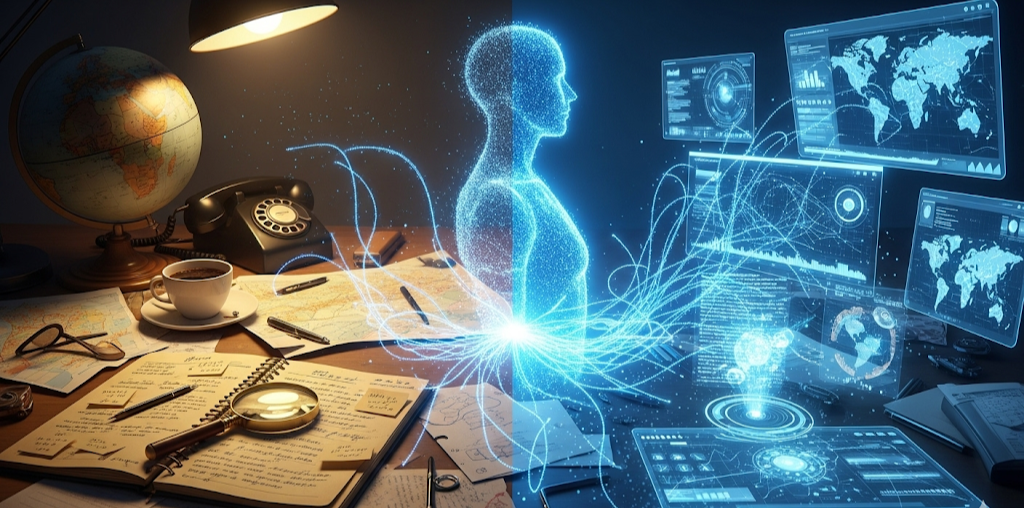Open-Source Intelligence (OSINT) has been a vital component of modern intelligence operations for decades. By collecting and analyzing publicly available data, OSINT has empowered businesses, government agencies, and law enforcement to gather crucial information. However, with the rise of Artificial Intelligence (AI), a growing debate has emerged: Is traditional OSINT dead with AI?
In this article, we’ll explore how AI is transforming traditional OSINT methods, examine the role of AI in intelligence gathering, and discuss whether traditional OSINT is truly becoming obsolete.
What is Traditional OSINT?
Before diving into the impact of AI, it’s important to understand what traditional OSINT entails. Traditional OSINT involves collecting and analyzing publicly available data from a variety of sources. These sources can include:
-
Social media platforms (e.g., Twitter, Facebook, LinkedIn)
-
Public records (e.g., government databases, company filings)
-
News websites and blogs
-
Forums and online communities
-
Geospatial data (e.g., satellite images, maps)
OSINT has long been a manual process, requiring analysts to sift through vast amounts of data to identify patterns, trends, and potential threats. While this process is effective, it is time-consuming and prone to human error.
How AI is Changing OSINT
AI-powered tools are dramatically reshaping how OSINT is conducted. By automating data collection and analysis, AI can process and interpret massive datasets much faster than humans. Here are some key ways AI is transforming OSINT:
1. Automating Data Collection
AI algorithms can crawl and collect data from a multitude of sources at a speed that traditional OSINT methods simply cannot match. Whether it’s social media platforms, news sites, or government databases, AI can aggregate relevant information within seconds. This efficiency reduces the manual effort required and increases the volume of data that can be processed.
2. Advanced Data Analysis and Pattern Recognition
AI tools can analyze patterns, correlations, and trends within massive datasets that would be overwhelming for human analysts. Machine learning algorithms are particularly useful for identifying anomalies and detecting emerging threats. For example, AI-powered sentiment analysis tools can scan social media to identify public opinion on political matters, brand perceptions, or potential security threats.
3. Real-Time Analysis and Predictive Intelligence
One of the significant advantages of AI is its ability to analyze data in real-time. Traditional OSINT may involve delayed analysis, where information is processed only after it’s gathered. In contrast, AI can offer real-time insights into critical events, enabling faster decision-making. AI-driven predictive analytics can even anticipate future threats or trends based on historical data, providing intelligence ahead of time.
4. Multimodal Intelligence Gathering
AI can process and analyze diverse types of data, from text to images and video. Computer vision technologies allow AI systems to interpret images, such as identifying objects or facial recognition. This ability to gather and analyze multimodal data expands the scope of OSINT, allowing analysts to gather intelligence from a wider range of sources, such as surveillance footage or geospatial data.
Is Traditional OSINT Really Dead?
While AI has undeniably revolutionized the OSINT field, the question remains: Is traditional OSINT dead? The answer is not so simple. Traditional OSINT is still valuable, but it must evolve in tandem with AI to remain effective. Here are some reasons why traditional OSINT is far from obsolete:
1. Human Expertise is Still Necessary
AI excels at processing data and identifying patterns, but human expertise is still crucial when it comes to contextualizing and interpreting that data. OSINT analysts bring a wealth of experience and understanding that AI lacks. For instance, they can discern cultural nuances, verify the credibility of sources, and provide insight into the motivations behind specific actions or statements.
2. Ethical Considerations and Privacy Concerns
AI in OSINT has raised important ethical and privacy concerns. While AI can gather vast amounts of data, it’s up to human analysts and organizations to ensure that the data is used responsibly. For instance, the use of facial recognition technology may raise privacy issues, especially when it comes to surveillance. Traditional OSINT methods, while slower, can be more deliberate in ensuring privacy and adhering to ethical guidelines.
3. Dealing with Misinformation and Bias
AI-driven tools are only as good as the data they are trained on. In the age of deepfakes and AI-generated misinformation, relying solely on AI can lead to inaccurate conclusions. Human analysts are better equipped to critically assess data, especially when dealing with false information or biased sources.
4. Complementary Nature of AI and Traditional OSINT
Rather than replacing traditional OSINT, AI should be seen as a complementary tool. AI can handle the heavy lifting of data collection and analysis, while human analysts focus on higher-level tasks like decision-making, verification, and strategic planning. Together, AI and traditional OSINT create a more efficient and powerful intelligence-gathering ecosystem.
Real-Life Examples of AI Enhancing OSINT
Let’s take a look at some real-world applications of AI in OSINT:
Example 1: Social Media Monitoring for Threat Detection
In 2020, a leading cybersecurity firm used AI-powered OSINT tools to monitor social media for signs of cyberattacks on a major financial institution. The AI system detected unusual patterns in online forums and social media platforms, allowing the firm to alert the client of a potential attack before it occurred. AI’s ability to analyze vast amounts of data in real-time played a crucial role in this early warning system.
Example 2: Predictive Analytics in Crisis Management
During the COVID-19 pandemic, governments and health organizations used AI-driven OSINT tools to monitor public sentiment and predict the spread of the virus. By analyzing news reports, social media conversations, and government updates, AI could forecast potential hotspots and offer valuable insights for resource allocation and containment strategies.
The Future of OSINT: Integrating AI and Human Intelligence
As AI continues to evolve, the future of OSINT will likely involve a more seamless integration of AI and human intelligence. Rather than being replaced, traditional OSINT will be enhanced by AI tools that automate routine tasks, analyze vast datasets, and offer predictive insights.
The role of human analysts will continue to be critical in ensuring the accuracy, ethics, and contextual understanding of intelligence. In the coming years, we can expect a hybrid model where AI and human expertise work together to provide faster, more accurate, and actionable intelligence.
Conclusion: Traditional OSINT is Not Dead, It’s Evolving
AI has certainly reshaped the landscape of Open-Source Intelligence, but it hasn’t made traditional OSINT methods obsolete. Instead, it has provided new tools and techniques that enhance the capabilities of OSINT analysts. While AI can handle the heavy lifting of data collection, human expertise remains crucial in interpreting and contextualizing that data.
In short, traditional OSINT is not dead with AI. It’s evolving into something more powerful and efficient. By embracing both AI and human intelligence, we can create a more effective and ethical intelligence-gathering ecosystem.
FAQ
Q1: How is AI used in OSINT?
AI is used in OSINT to automate data collection, analyze vast datasets for patterns, and provide real-time insights. AI tools can also enhance multimodal intelligence gathering, such as analyzing images and video content.
Q2: Is traditional OSINT still relevant?
Yes, traditional OSINT is still relevant, especially for providing context, ensuring ethical use of data, and verifying information. It works hand-in-hand with AI to provide comprehensive intelligence.
Q3: Can AI replace human OSINT analysts?
While AI can handle many tasks in OSINT, human analysts are still essential for interpreting data, understanding context, and making strategic decisions. AI and human expertise are most effective when used together.
Q4: What are the challenges of using AI in OSINT?
Some challenges include ethical concerns, privacy issues, and the potential for bias or misinformation. AI’s ability to handle large datasets doesn’t guarantee that the data is accurate or reliable.
Q5: What’s the future of OSINT with AI?
The future of OSINT lies in a hybrid approach, where AI handles data processing and analysis, and human analysts provide context, ethical oversight, and decision-making. This integration will make intelligence-gathering faster and more accurate.








Leave a Reply